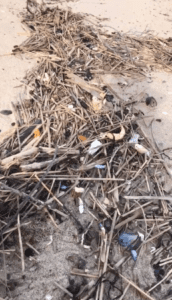Natalie MacDonald, 2021 Joanna Toole Intern
At the end of September, I completed my first Outer Cape Cleanup (OCC) with the Beach Brigade – one of the many activities I’ve participated in as the Joanna Toole “Ghost Gear” intern. Started by local shellfisherman Anthony Daley, the OCC is completed yearly as participants walk from Coast Guard Beach in Eastham to Race Point in Provincetown over the course of four days, collecting debris on the beach. I participated in three of the four days, walking from Lecount Hollow in Wellfleet to Race Point.
Each day was a slightly different crowd of people. Many of us came from different backgrounds and towns, but were all united under the same goal. Some people had been participating in the Outer Cape Cleanup for years, while for others like myself it was the first time. Everyone had different strengths (and snacks and supplies!) that helped us work efficiently to collect as much debris as possible.
The journey could be disheartening at times. Seeing a few pieces of trash on your local beach is already painful to look at, but we crossed miles and miles of beach and found hundreds of pounds of debris. We found everything from fully intact lobster gear, to hypodermic needles, to pieces of plastic film. Even in the stretches where we didn’t see a single person, we were still finding plenty of debris. It’s sad to see the environment treated this way, whether intentional or not.
What resonated with me the most on this trek was “Styrofoam City”, a stretch of beach north of High Head Beach in Truro we encountered on the last day. We spent over an hour just sitting in the sand, picking the smallest bits of foamed polystyrene (what we refer to as Styrofoam) out of the wrack line. We could have spent all day just on this one section of beach. A lot of questions were raised during this part of the journey: Where is it all coming from? Why is it all washing up in this one specific stretch of beach? How old is it?
Polystyrene (#6 in the “triangle”) is not biodegradable, but instead breaks down into microplastics. It can be recycled, but only in proper facilities, which is just not feasible for the average consumer. It is used to make a lot of single-use items we see every day, like utensils, straws, and food packaging. When expanded, it becomes what we call Styrofoam. Because this material is so light and breaks down into such small pieces, we can’t even quantify it from a cleanup this large as it would take so long to count the individual pieces.
52 cities and towns in Massachusetts have banned some form of polystyrene, including Eastham, Wellfleet, and Provincetown. So why did we still find so much polystyrene in this stretch? While local bans are important, they are not the end-all solution. We don’t know the answers to all of these questions yet, but they need to be addressed.
My first Outer Cape Cleanup was definitely an experience that I will never forget. But Styrofoam City is the part I’ll be focusing on for a while.

Our Work
Humpback Whale Research
Right Whale Research
Marine Animal Entanglement Response
Marine Geology Department
Water Quality Monitoring Program
Marine Fisheries Research
Seal Research
Shark Research
Marine Education
Interdisciplinary
Marine Debris and Plastics Program
Marine Policy Initiative
Cape Cod Climate Change Collaborative
Publications




